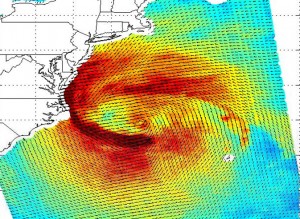 It’s not every day a campus emergency management team has to prepare for a “storm of the century,” but colleges across the East Coast braced themselves for the worst this week.
It’s not every day a campus emergency management team has to prepare for a “storm of the century,” but colleges across the East Coast braced themselves for the worst this week.
Now those teams can pat themselves on the back as they assess property damage and put together plans to repair damage and get the schools’ classes back up and running.
Preparing for a Storm Like Sandy
“We had to prepare for the worst,” said Scott Hood, Vice President of Communications and Public Affairs at Bowdoin College in Brunswick, Maine. “That means we had to meet several times with our emergency management team. Representatives from several sectors of the college, including those responsible for the grounds, electrical, mechanical, and dining facilities, all came together to make sure everything on our severe weather checklist was in order.”
“We weren’t sure what we were in for, but we knew we had to learn from the past.” Hood shared about the lessons Bowdoin learned back in the 1990s, when a severe ice storm crippled Colby & Bates College, leaving students without power for an extended period of time. Bowdoin wasn’t in session when the ice storm hit, but they took note of what happened at Colby & Bates and beefed up their emergency plan.
“We checked back up generators to make sure they were gassed up and ready to go,” Hood said. “Then we alerted students of emergency plans, making sure communication channels were open. We also checked on students and faculty that were traveling or planned to travel to areas that would be affected by the storm.”
Thinking Ahead in Maine
In Maine, the biggest concerns were wind and possible ice.
“Most of our buildings are substantial,” Hood said, “but we were particularly concerned about one set of apartments that was built in the 1970s. This structure is made of wood and is situated next to several pine trees.” Hood explained that they put into place an evacuation plan, in case high winds began to threaten the structure, preparing to move students to the safer buildings on campus.
Bowdoin closed down at 4:00 p.m. on Monday, and Hurricane Sandy swept through, rattling windows but causing little damage. Hood reported that they didn’t even lose power, even though they were prepared to handle outages. Now the emergency management team will meet again to debrief, celebrate the victory and plan for future storms.
Breathing a Sigh of Relief in Pennsylvania
Swarthmore College of Swarthmore, Pennsylvania also managed to get through the storm with minor damages. According to the Swarthmore College website, “Swarthmore’s facilities, public safety, dining services, and residential life offices worked around the clock to ensure students were safe and well cared for no matter what Hurricane Sandy brought to the region.”
The biggest concerns at this “Little Ivy” were about collateral damage from things such as falling branches. The schools advised students to stay inside, especially as the storm gained in intensity.
“In anticipation of the storm, record amounts of food were served on Monday during breakfast and lunch. As students left the dining hall for lunch on Monday, they were provided with the necessary fixings for a deli-type, takeout dinner to keep them inside when the storm made landfall that evening and to enable dining services staff to leave for their homes by 4 p.m., before conditions were expected to worsen in our area.”
Gratitude Prevails
Over all, Swarthmore campus officials are grateful to have gotten through the storm relatively unscathed.
“A special note of appreciation goes to our students who experienced the power outage and severe weather with good humor and in a spirit of community building and eagerness to help one another,” says Stu Hain, Vice President for Facilities and Services. “My deepest thanks, as well, to the environmental services, dining, and facilities staff members who put in long hours under some very difficult circumstances.”
Other Colleges Not So Lucky
Unfortunately, some college campuses were hit harder than Bowdoin and Swarthmore. Mostly because of flooding, New York City colleges were hit particularly hard. For example, several of NYU’s properties lost power, and NYU classes have been canceled through Saturday November 3rd.
Columbia was also forced to close classes and faces challenges due to transportation limitations. Trees were reported down at Wellesley College and Princeton University, and The Science Building of CUNY Queens College suffered minor damage. All in all, the biggest challenges are power outages, transportation challenges and property damage.
Chief Concern
Across the board, student safety was the primary concern. College officials take student safety very seriously, as they are aware that many college students are away from home for the first time and may not have given much thought to emergency situations.
Communication between students and faculty, as well as school and parents, was the key to staying calm and being prepared. Safety precautions were taken to ensure students were aware of risks and knew the emergency procedures.
The end result? Colleges survived Hurricane Sandy, the storm of the century, and students now have “super storm” tales to tell.
